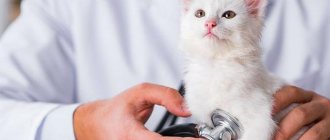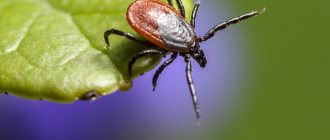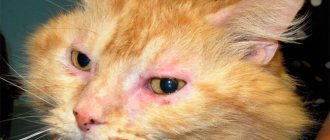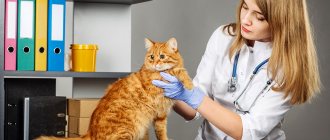The danger of contracting infectious diseases awaits pets everywhere. Due to their behavior - catching a mouse or a street pigeon while playing - cats are at high risk of contracting such a serious infection as salmonellosis. An infection that, based on its initial manifestations, can be mistaken for banal poisoning or another viral disease.
Cunning and the danger of infection
This is the insidiousness of salmonellosis. The manifestation of early clinical symptoms when infected with this infection is similar to the signs of a viral disease such as panleukopenia - “feline distemper”:
- the animal becomes lethargic, constantly hides in secluded places, almost never leaving them even to eat or drink;
- body temperature reaches critical levels;
- vomiting and diarrhea appear;
- There may be blood in the feces.
Salmonellosis in cats is a bacterial infection caused by Salmonella. The disease develops very rapidly and can be fatal. The characteristics of the pathogen, Salmonella bacteria, are that they are extremely persistent and survive in the most unfavorable environmental conditions. At low or high temperatures they remain viable for a long time.
For timely assistance and prescribing antibacterial therapy, it is very important not to confuse the disease. At the first suspicion of this bacterial infection, laboratory tests should be performed to confirm the diagnosis.
What symptoms are accompanied by
The main symptoms of the disease include:
- When cats are sick, they do not allow their bellies and sides to be touched. The animal hisses upon contact, tries to run away and may become aggressive. Poor appetite. The cat may eat small portions or refuse food completely. Most often, the desire to eat something is absent, the animal turns away from the food and does not try to approach the bowl. The pet may refuse to drink. This condition is more dangerous because After 2 days, irreversible changes begin. For kittens, the period is reduced to 4-6 hours.
- Increased body temperature. Indicators can reach 42 °C. Sometimes the temperature does not stay constant and can even alternate with loss of strength.
- Vomit. Maybe with foam. In severe cases, attacks can even be triggered by drinking water. Then urgent intravenous administration of solutions is required. Frequent licking may indirectly indicate nausea. Sometimes animals sit for a long time near a bowl of water.
- Apathy. The animal becomes lethargic, moves little, and does not want to play.
- Diarrhea. The presence of blood in the stool is an alarming sign. Both individual streaks and completely black feces are observed.
- Respiratory disorders. More often - cough. They indicate the imminent onset of death.
The pet tries to stay away from others and prefers secluded, quiet places.
Diagnosis of infection
Due to the fact that salmonellosis has non-specific symptoms in cats and its manifestations are similar to other viral or bacterial diseases, special studies are first carried out. A cat should be checked for salmonellosis using a number of tests that are carried out in the laboratory of a veterinary hospital:
- clinical tests of the animal’s blood and urine are needed to confirm the presence of a bacterial infection and check kidney function;
- biochemical blood parameters allow you to assess the severity of damage to the liver and pancreas;
- The condition and size of the animal’s internal organs are examined using an ultrasound machine.
Only after a bacteriological examination of the cat’s feces and identification of the causative agent of the disease in them can an accurate diagnosis be made.
How to check your pet?
If you suspect this disease, you cannot do without contacting a veterinary clinic.
If cat owners suspect that they have salmonellosis, it is important to contact a veterinary clinic as soon as possible, where feces and vomit will be analyzed for the presence of bacteria. Sometimes a bacteriological blood test is also required. In addition, it is recommended to check for the presence of bacteria in the suspected food, which could have caused the cat to become infected.
Sources of infection
Salmonellosis in cats can occur:
- after eating milk or raw meat of infected farm animals or birds;
- when eating other contaminated food, eggs, fish;
- from cats - carriers of infection through contact with their feces;
- after contact with other infected animals - rodents, birds;
- due to improper care and non-compliance with hygiene rules;
- due to reduced immunity during the period of teeth change, due to past diseases of the gastrointestinal tract, the presence of worms;
- in kittens in utero through the placenta from a sick pregnant cat.
What should you know about salmonellosis?
Salmonellosis
– a disease caused by gram-negative facultative anaerobic bacteria belonging to the genus Salmonella. Species such as Salmonella paratyphi and Salmonella typhi, which cause “typhoid-like” forms of the disease, pose a danger to humans.
In addition, there are many types of salmonella that pose a danger to animals. They enter the body with contaminated food or water. Thus, in cats, salmonellosis can occur as a result of eating raw contaminated meat, milk and eggs, or contact with the feces of sick animals. Quite often, outbreaks of salmonellosis among cats occur in areas located near poultry houses, farms, meat processing plants, slaughterhouses, and burial sites for animal remains.
Incubation period and development of the disease
After entering the body, the causative agents of salmonellosis begin to multiply and poison the host with the products of their vital activity - endotoxins. As a result, an inflammatory process occurs in the intestines.
Toxins accumulate in the body and affect the vessels of the intestinal wall, increasing its permeability. If the cat's body has insufficient resistance, endotoxins:
- cause areas of hemorrhage on the mucous membranes;
- provoke degenerative changes in organs - intestines, liver, kidneys, spleen;
- penetrate the body’s lymphatic system and general bloodstream, causing the development of sepsis - blood poisoning;
- affects all organs and systems - the brain, joints, lungs.
When bacteria infect all organs and tissues of the body, liver, kidney, and pulmonary failure develops and the death of the animal occurs.
The incubation period after infection ranges from several days to three weeks. The appearance of the first signs of manifestation may be acute or resemble the malaise of mild poisoning. It depends on the age of the pet. The infection is extremely dangerous for kittens, as they tolerate it extremely hard and can die on the second day of illness.
The disease is extremely contagious. If there are other pets in the house besides the cat, they must be isolated. In dogs, the symptoms that occur when infected are the same.
The course of the disease, its severity and the form of salmonellosis depend on the stability of the cat’s immunity.
Forms of the disease
There are acute forms of the disease, subacute and chronic.
The acute form develops when a large number of bacteria - pathogens and their toxins - enter the body. It is characterized by:
- a rapid rise in temperature to very high levels. It remains high throughout the entire period of illness;
- complete refusal of food;
- almost continuous watery diarrhea, vomiting;
- purulent discharge from the eyes and nose;
Vomiting is preceded by hypersalivation. Feces may contain blood and mucus.
Frequent vomiting and profuse diarrhea threaten dehydration and severe intoxication. In this condition, the animal may die already on the second day after the onset of salmonellosis.
The subacute form develops with the same symptoms only of less intensity. Dehydration may not occur as quickly as during an acute infection.
The chronic form of salmonellosis depletes the animal's body. When poisoned by bacterial waste products, purulent conjunctivitis, pneumonia, and anemia develop. Death can occur within a month after the onset of the disease.
How to treat salmonellosis in cats
First, it is necessary to provide the animal with high-quality food and keep it in favorable conditions. These criteria will help your pet recover faster. Milk can be replaced with yogurt or kefir.
It is strictly forbidden to treat such a dangerous disease as salmonellosis at home, since it can kill your beloved pet. At the first suspicion of salmonellosis, you should seek help from an experienced veterinarian, and only after making a diagnosis will he prescribe appropriate treatment.
The doctor will focus on eliminating diarrhea caused by infection, but the main treatment is antibiotics.
The veterinarian will also prescribe sulfonamide medications in a comprehensive manner, including:
- hyperimmune serum that fights salmonellosis and colibacillosis in domestic animals and birds;
- use of Bacteriophage for three days, 10 milliliters at a time;
- Fusarolidone is widely used in the treatment of this infection, it is taken 30 milligrams per kilogram of weight, twice a day before meals, the course is 7 days;
- Oxytetracycline is given to kittens for 5 days at a dose of 0.1 grams per kilogram of weight.
Furazolidone is used to treat salmonellosis in cats.
The course of treatment is usually 5-7 days, but if necessary, the doctor can extend the treatment up to 10 days. In acute form, subcutaneous injections of camphor oil, 20 percent solution of caffeine and glucose are prescribed.
To prevent irreversible consequences, the animal is injected with buffer compounds intravenously, and drugs that protect the liver are added.
After the slightest relief, cats are given a strict diet in the form of:
- boiled rice porridge;
- boiled chicken;
- liver;
- greenery;
- various vegetables, steamed and mashed through a sieve.
The duration of the illness is usually one and a half to two weeks, then the body recovers; during this time there should be no stress on the digestive organs and stomach.
We suggest you read: How to give a cat a deworming tablet
First aid and treatment
Trying to cure your pet of salmonellosis on your own is dangerous for his life. A cat can die very quickly from complications developing due to infection.
At home, it is possible to provide only first aid and symptomatic therapy - treatment should only be carried out by a veterinarian.
First aid is to reduce the level of intoxication:
- The stomach is washed to remove any remaining contaminated food. The procedure is carried out only with water - about 40 ml is poured into the cat from a syringe, then vomiting is caused;
- To cleanse the intestines, do an enema with boiled water. It is necessary to pour in about 100 ml until clean water appears from the intestines;
- To neutralize the effects of toxins and remove them from the intestines, sorbents are used - Enterosgel, Activated carbon. The dose of the drug is calculated according to the instructions and depends on the weight of the animal;
- with a small volume of water, about 10 ml, the cat is given water every 15 minutes.
Treatment of the infection is complex and lasts about two weeks. It consists of the following purposes:
- hyperimmune serum to build immunity against salmonellosis;
- saline drips to combat dehydration;
- antiemetics;
- furazolidone - an antimicrobial drug active against Salmonella bacteria;
- hepatoprotectors to protect the liver from the harmful effects of powerful antibiotics;
- diet and gentle feeding of the cat.
Antibiotics and sulfonamide drugs are the main means of combating salmonellosis pathogens. Use them within a week. To provide an immunoregulatory effect, sick animals are prescribed glucocorticoids - synthetic corticosteroid hormones.
It must be remembered that immunity to this disease is not developed. A cat can become infected several times during its life.
Therefore, precautions must always be present.
Why is salmonellosis dangerous?
Cats can get salmonellosis several times in their lives. Their bodies do not develop immunity to the pathogens of this disease. In kittens, salmonellosis often leads to death. In adult cats, it can cause severe complications and pathological processes, which include:
- infectious-toxic shock - a condition that develops against the background of severe intoxication and a large amount of loss of fluid, electrolytes, and damage to the adrenal glands;
- dehydration – occurs due to excessive vomiting and diarrhea;
- pancreatitis - inflammation of the pancreas;
- Acute renal failure most often develops in kittens. Against the background of intoxication syndrome, the kidneys stop cleaning and filtering the blood.
Prevention of infection
You need to pay enough attention to caring for animals. To protect them from the risk of infection you need to:
- keep the cat and kittens clean, always follow the rules of hygiene for them, give them only clean water to drink;
- exclude contact of your pet with street animals;
- include meat in the diet, the quality of which is beyond doubt;
- for preventive purposes, it is advisable to heat treat meat, milk and eggs;
- do not allow a sudden change from one food to another in the first days of feeding kittens;
- Buy industrial feed only of good quality.
Safety regulations
Of course, this site does not belong to the medical category, but it is important for you to realize that salmonellosis is a disease that poses a direct danger to the life and health of not only animals, but also humans themselves. Your main task is not to cure your pet, but, no matter how cynical it may sound, to protect yourself from infection. What can you do to prevent salmonellosis in you and your family? There are several simple measures that can relatively reliably protect a person from the danger of contracting this disease.
Salmonellosis in cats is a common disease. An animal can become infected with it from infected fresh meat. This intestinal infection is most dangerous for kittens. In this article, we reviewed the main causes, symptoms, methods of diagnosis and treatment of salmonellosis in cats.
Danger to others
Salmonellosis also poses a danger to pet owners. There is a risk of transmission of salmonella bacteria from an infected cat to humans. Therefore, after contact with a sick pet, you need to follow the rules of hygiene especially carefully:
- a sick cat should be isolated not only from other animals, but also from family members, especially children;
- disinfect those items that were used when caring for an infected cat;
- After handling a sick pet, hands should be washed twice with soap.
Even after treatment ends, the cat may remain contagious. Bacteria - pathogens - will be present in the feces. Her contact with other animals should be limited.
Is salmonellosis scary for people?
All pet owners need to know that salmonellosis is a common disease of humans and animals, so both a person and an animal can become infected, and vice versa. Therefore, the owner of a sick animal needs to take this very seriously, namely, follow all hygiene rules while caring for the cat.
Always wash your hands with soap and water before eating and when caring for an infected animal. To avoid infection, it is better not to squeeze your pet; you should wait until it recovers.
Salmonellosis is transmitted to humans from cats through direct contact.
All pet owners need to know that salmonellosis is a common disease of humans and animals, so both a person and an animal can become infected, and vice versa. Therefore, the owner of a sick animal needs to take this very seriously, namely, follow all hygiene rules while caring for the cat.











